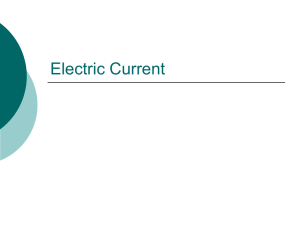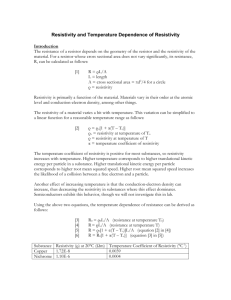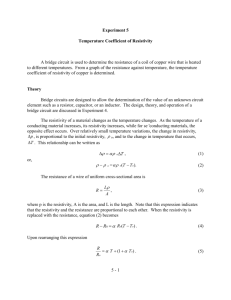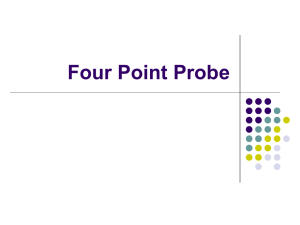The Temperature Dependence of Resistance
advertisement
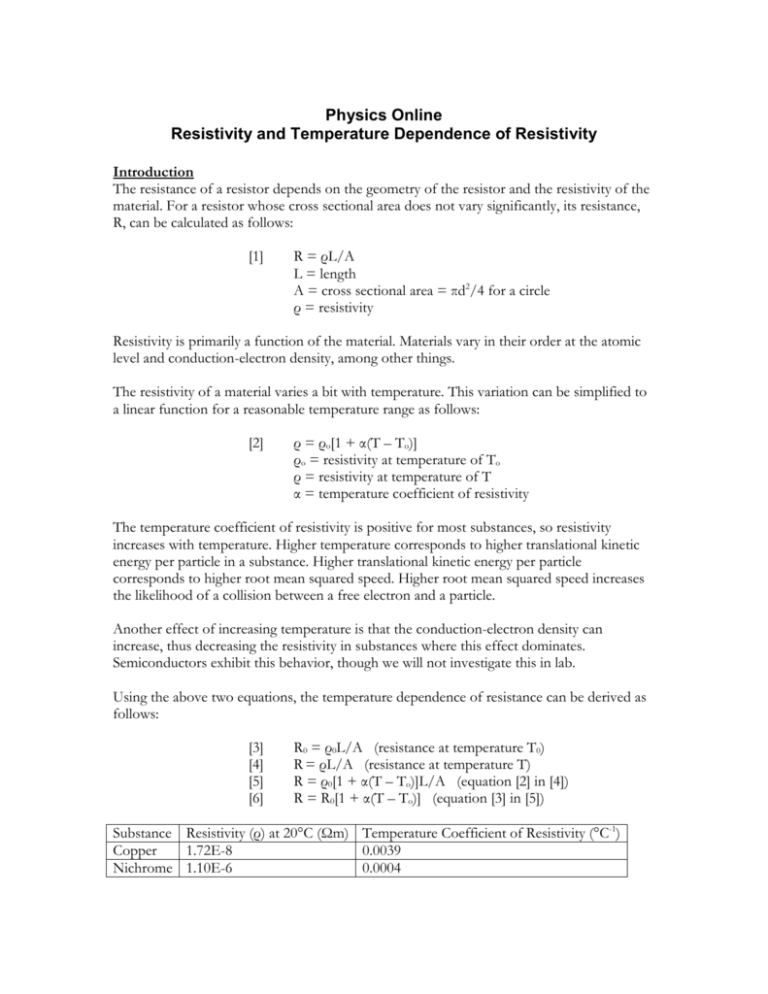
Physics Online Resistivity and Temperature Dependence of Resistivity Introduction The resistance of a resistor depends on the geometry of the resistor and the resistivity of the material. For a resistor whose cross sectional area does not vary significantly, its resistance, R, can be calculated as follows: [1] R = ρL/A L = length A = cross sectional area = πd2/4 for a circle ρ = resistivity Resistivity is primarily a function of the material. Materials vary in their order at the atomic level and conduction-electron density, among other things. The resistivity of a material varies a bit with temperature. This variation can be simplified to a linear function for a reasonable temperature range as follows: [2] ρ = ρo[1 + α(T – To)] ρo = resistivity at temperature of To ρ = resistivity at temperature of T α = temperature coefficient of resistivity The temperature coefficient of resistivity is positive for most substances, so resistivity increases with temperature. Higher temperature corresponds to higher translational kinetic energy per particle in a substance. Higher translational kinetic energy per particle corresponds to higher root mean squared speed. Higher root mean squared speed increases the likelihood of a collision between a free electron and a particle. Another effect of increasing temperature is that the conduction-electron density can increase, thus decreasing the resistivity in substances where this effect dominates. Semiconductors exhibit this behavior, though we will not investigate this in lab. Using the above two equations, the temperature dependence of resistance can be derived as follows: [3] [4] [5] [6] R0 = ρ0L/A (resistance at temperature T0) R = ρL/A (resistance at temperature T) R = ρ0[1 + α(T – To)]L/A (equation [2] in [4]) R = R0[1 + α(T – To)] (equation [3] in [5]) Substance Resistivity (ρ) at 20°C (Ωm) Temperature Coefficient of Resistivity (°C-1) Copper 1.72E-8 0.0039 Nichrome 1.10E-6 0.0004 Copper has a low resistivity due to its high conduction electron density and ordered structure. Nichrome has a high resistivity for a metal due to the high resistivity of nickel and chromium plus the disorder created by the mixing of the two materials. Most wire is listed by “gauge” which can be connected to diameter with the following table: Gauge Diameter (mm) 30 0.254 32 0.203 36 0.127 Equipment You Procure digital camera pot of water and stove bowl of ice water metric tape measure oven mitts or some means of protection for your hands Equipment from Kits 1 digital multi-meter (DMM) 2 clips 4 nichrome wires (bare wires of varied thickness and length). The thicker nichrome is 32 gauge while the thinner nichrome is 36 gauge 4 coils of copper wire (next to DMM) OR 1 copper or “nickel silver” resistance coil (lower right). Lengths and gauges are listed on the coils. Experimental Procedure Resistivity at Room Temperature 1) 2) 3) 4) 5) 6) 7) 8) Measure the resistance of the ohmmeter and probes by connecting the two probes. Measure or use a given value for the length of a piece of wire. Find the diameter of the wire from the gauge table. Measure the resistance of the wire with the digital multi-meter configured as an ohmmeter. Make good contact with the wire by pressing firmly. Use the entire length of the wire. Subtract the value obtained in step 1 from the value obtained in step 4. Solve equation [1] for resistivity (ρ) and calculate your experimental value. Scientifically compare your experimental value for resistivity to the theoretical value in the first table. If it is Repeat steps 2 through 7 with all the other wires. The temperature dependence of resistance 1) Place the pot of water on the stove. Turn the stove to the highest setting until you bring the water to a gentle boil. 2) Fill a bowl with ice water. 3) Connect your highest resistance copper wire or your resistance coil to the DMM configured as an ohmmeter. Make good contact with the wire by using clips. 4) Immerse the wire in the ice water. 5) Measure the resistance of the wire every minute or so until you obtain a constant value. Subtract the resistance of the ohmmeter and probes from your last measurement to determine R0. 6) Use your knowledge of physics to infer the temperature of the ice water and hence the temperature of the wire, T0. 7) Place the wire in the boiling water. Leave the ends of the wire sticking out of the hot water. 8) Measure the resistance of the wire every minute or so until you obtain a constant value. Subtract the resistance of the ohmmeter and probes from your last measurement to determine R. 9) Use your knowledge of physics to infer the temperature of the boiling water and hence the temperature of the wire, T. 10) Solve equation [6] for the temperature coefficient of resistivity (α) and calculate your When calculating alpha, do not use any data obtained in the room temperature experiment except for the resistance of the ohmmeter and probes. experimental value. 11) Scientifically compare your single experimental value for temperature coefficient of resistivity to the theoretical value. When calculating alpha, do not use any data obtained in the room temperature experiment except for the resistance of the ohmmeter and probes. 12) Repeat steps 3 through 11 with your highest resistance nichrome wire. 13) Re-read and obey the above sentence in gigantic bold font. If you disobey those instructions, then you risk a zero on your report. Sharing Data for the Resistance Coil If you have a resistance coil, then share your raw data for this coil on the discussion board. Include data and calculations for at least four resistance coils in your report.





